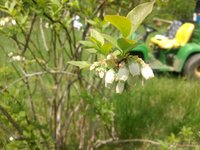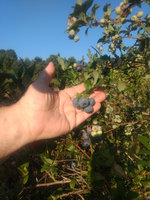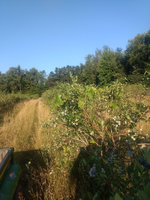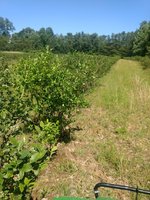Leo in N E Illinois
The Professor
- Messages
- 11,465
- Reaction score
- 23,750
- USDA Zone
- 5b
I have highbush blueberry plants, select varieties for fruit production, 2 to 4 years from tissue culture. These are Vaccinium corymbosum varieties.
Blueberries can make a nice bonsai, or kusamono, they do not make big thick trunks very quickly, but they can be pleasant. White urn shaped flowers in spring, even on very young plants. Delicious blue fruit ripens in July. The autumn leaf colors is lovely from yellow through red to purple. The 'Sweetheart' variety has a faint blue-ish cast to its foliage.
If you do not have highly acidic soils, backyard growing for fruit production should be done as container growing. A 20 gallon nursery pot with a "blueberry media" can produce roughly 3 to 7 pounds a year of fruit. Nothing beats the flavor of fresh Highbush Blueberries, Vaccinium corymbosum. And while in the container for fruit production, the bush will be sizing up, once trunks are large enough for bonsai, you can convert the bush from fruit production to a bonsai tree if you are not addicted to fresh blueberries for a few weeks in July.
Blueberries can be purchased at big box stores and many landscape nurseries for roughly $10 each in quart to gallon containers. If you can get 'Bluecrop', 'Elizabeth', 'Duke', 'Bonus', 'Chandler' or 'Draper' for that price, these are some of the best flavored blueberries out there, get them at your big box. But if you can not find them locally, I can supply similarly good tasting varieties to you. Remember shipping will be at least $12. The 'Blueboy', 'Bluejay', 'Pink Lemonade' and lowbush varieties are inferior in flavor to the ones I'm offering. So avoid those from your garden center if you are interested in fruit. If you are interested in bonsai the lowbush blueberries (Vaccinium angustifolium) are particularly good for kusamono.
I will ship you "dug ups" between 12 inches and 36 inches tall. They will not be potted, potting media and roots will be wrapped in plastic. They will be $7.50 each. These are all flowering size, but they are only single and double stems, so they will have a small handful of berries in 2022, they will be producing 3 or more pounds their third year after potting into a 20 gallon or larger pot. The pot should be low and wide, deeper than 8 inches is not needed, wider than 12 inches is needed.
Potting media should be a blend of 50 parts Canadian Peat, 50 parts of bark, I prefer 1/8 to 1/4 inch size fir bark from local Orchid supply, and to this add about 5 parts of hardwood sawdust to feed the soil mycorrhiza. IF your water has more than 100 ppm as calcium carbonate add roughly one tablespoon (15 ml) per gallon of mix of sulfur for soil acidification. If your water is over 300 parts per million as calcium carbonate add 2 tablespoons per gallon of sulfur for soil acidification and try to use rain water as often as possible to water your blueberries. When potted into a 20 gallon nursery pot or similar volume, (prefer lower and wider container), simply top dress with fir bark every autumn. You should not have to repot for 10 years or more. Acid plant fertilizer only. There should be no added calcium in the fertilizer chosen. See my other thread offering Blueberry Special Fertilizer. Organic fertilizers work well, and liquid seaweed extracts and or humic acid solutions are appreciated by the blueberries but not mandatory.
The varieties I am offering are fully winter hardy through zone 5b with pots simply set on the ground. Colder than 5a you may need to heel in the pots or provide some protection. Flower buds are damaged at -16 F and lower. Damage begins for vegetative buds at - 20 F. Most require winter chill equivalent to zone 7a or colder. Do not "over protect" your blueberries in winter. The winter requirement is a minimum of 800 to 1000 chill hours. Less than 800 chill hours might have problems with blooming in spring.
Pests - blueberries can be relatively pest free. Unfortunately China has gifted us with a major pest problem. Spotted Wing Drosophila (SWD) a fruit fly that attacks fruit just as it turns blue. One way to beat this pest is by cultivar choice. All the choices I am offering the fruit ripens early enough that in most cases, the fruit will be ready to harvest before the first big flush of SWD emerges. This is the reason we never grew any of the late ripening varieties of blueberries. It allowed us to have "no spray" blueberries. Pyrethrum sprays, which have both OMRI and non-organic formulations available work fairly well against SWD if you have picked up later ripening varieties elsewhere. I offer early varieties in order to eliminate the need for sprays.
'Sweetheart' - this is the earliest of our blueberries. In South Haven Michigan area it ripens last week of June through first week of July. Berries smaller than 'Bluecrop' and 'Duke' but bigger than 'Elliot' and other late season berries. Very sweet, mild acidity. A great blueberry for eating fresh. Height 4 to 6 feet tall at maturity, self fertile, higher yield if cross pollinated with northern or southern highbush varieties, only needs 800 chill hours, good for zone 5b through 7b. More warmth tolerant than my other offerings. Dug Ups - $7.50 each.
'Huron' - this is slightly later than 'Sweetheart' ripens with 'Duke' and a week ahead of 'Bluecrop', normally first week of July. Fruit size is good, flavor has nice profile sweet with the right amount of tartness. A very good early blueberry, possibly better flavor than 'Duke'. Plant height 4 to 6 feet at maturity, hardy through zones 5a to 7a. Small plants - $5, medium size $7.50
'Toro' - this ripens a week after 'Bluecrop' begins and finishes with 'Bluecrop', a more concentrated ripening habit. This variety has large berries with thick skins that somewhat resist SWD. Flavor profile is quite good, sweet and just slightly less tart than 'Bluecrop'. Only down side is fruit can be ripe when face of berry is black and back side is still slightly green. Also the berry does not have the blue bloom that the other varieties are famous for. Alleged to have thicker branches and trunks than any other northern highbush, (hence might be better for bonsai) but to date have not noticed much difference. Limited supply $10 each. Zone 5b to 7a.
Shipping will be via USPS Priority
PM me if interested.
blueberry flowers in May

Full size 6 foot tall bush with fruit

row of blueberries almost ready for first picking July 6

Blueberries can make a nice bonsai, or kusamono, they do not make big thick trunks very quickly, but they can be pleasant. White urn shaped flowers in spring, even on very young plants. Delicious blue fruit ripens in July. The autumn leaf colors is lovely from yellow through red to purple. The 'Sweetheart' variety has a faint blue-ish cast to its foliage.
If you do not have highly acidic soils, backyard growing for fruit production should be done as container growing. A 20 gallon nursery pot with a "blueberry media" can produce roughly 3 to 7 pounds a year of fruit. Nothing beats the flavor of fresh Highbush Blueberries, Vaccinium corymbosum. And while in the container for fruit production, the bush will be sizing up, once trunks are large enough for bonsai, you can convert the bush from fruit production to a bonsai tree if you are not addicted to fresh blueberries for a few weeks in July.
Blueberries can be purchased at big box stores and many landscape nurseries for roughly $10 each in quart to gallon containers. If you can get 'Bluecrop', 'Elizabeth', 'Duke', 'Bonus', 'Chandler' or 'Draper' for that price, these are some of the best flavored blueberries out there, get them at your big box. But if you can not find them locally, I can supply similarly good tasting varieties to you. Remember shipping will be at least $12. The 'Blueboy', 'Bluejay', 'Pink Lemonade' and lowbush varieties are inferior in flavor to the ones I'm offering. So avoid those from your garden center if you are interested in fruit. If you are interested in bonsai the lowbush blueberries (Vaccinium angustifolium) are particularly good for kusamono.
I will ship you "dug ups" between 12 inches and 36 inches tall. They will not be potted, potting media and roots will be wrapped in plastic. They will be $7.50 each. These are all flowering size, but they are only single and double stems, so they will have a small handful of berries in 2022, they will be producing 3 or more pounds their third year after potting into a 20 gallon or larger pot. The pot should be low and wide, deeper than 8 inches is not needed, wider than 12 inches is needed.
Potting media should be a blend of 50 parts Canadian Peat, 50 parts of bark, I prefer 1/8 to 1/4 inch size fir bark from local Orchid supply, and to this add about 5 parts of hardwood sawdust to feed the soil mycorrhiza. IF your water has more than 100 ppm as calcium carbonate add roughly one tablespoon (15 ml) per gallon of mix of sulfur for soil acidification. If your water is over 300 parts per million as calcium carbonate add 2 tablespoons per gallon of sulfur for soil acidification and try to use rain water as often as possible to water your blueberries. When potted into a 20 gallon nursery pot or similar volume, (prefer lower and wider container), simply top dress with fir bark every autumn. You should not have to repot for 10 years or more. Acid plant fertilizer only. There should be no added calcium in the fertilizer chosen. See my other thread offering Blueberry Special Fertilizer. Organic fertilizers work well, and liquid seaweed extracts and or humic acid solutions are appreciated by the blueberries but not mandatory.
The varieties I am offering are fully winter hardy through zone 5b with pots simply set on the ground. Colder than 5a you may need to heel in the pots or provide some protection. Flower buds are damaged at -16 F and lower. Damage begins for vegetative buds at - 20 F. Most require winter chill equivalent to zone 7a or colder. Do not "over protect" your blueberries in winter. The winter requirement is a minimum of 800 to 1000 chill hours. Less than 800 chill hours might have problems with blooming in spring.
Pests - blueberries can be relatively pest free. Unfortunately China has gifted us with a major pest problem. Spotted Wing Drosophila (SWD) a fruit fly that attacks fruit just as it turns blue. One way to beat this pest is by cultivar choice. All the choices I am offering the fruit ripens early enough that in most cases, the fruit will be ready to harvest before the first big flush of SWD emerges. This is the reason we never grew any of the late ripening varieties of blueberries. It allowed us to have "no spray" blueberries. Pyrethrum sprays, which have both OMRI and non-organic formulations available work fairly well against SWD if you have picked up later ripening varieties elsewhere. I offer early varieties in order to eliminate the need for sprays.
'Sweetheart' - this is the earliest of our blueberries. In South Haven Michigan area it ripens last week of June through first week of July. Berries smaller than 'Bluecrop' and 'Duke' but bigger than 'Elliot' and other late season berries. Very sweet, mild acidity. A great blueberry for eating fresh. Height 4 to 6 feet tall at maturity, self fertile, higher yield if cross pollinated with northern or southern highbush varieties, only needs 800 chill hours, good for zone 5b through 7b. More warmth tolerant than my other offerings. Dug Ups - $7.50 each.
'Huron' - this is slightly later than 'Sweetheart' ripens with 'Duke' and a week ahead of 'Bluecrop', normally first week of July. Fruit size is good, flavor has nice profile sweet with the right amount of tartness. A very good early blueberry, possibly better flavor than 'Duke'. Plant height 4 to 6 feet at maturity, hardy through zones 5a to 7a. Small plants - $5, medium size $7.50
'Toro' - this ripens a week after 'Bluecrop' begins and finishes with 'Bluecrop', a more concentrated ripening habit. This variety has large berries with thick skins that somewhat resist SWD. Flavor profile is quite good, sweet and just slightly less tart than 'Bluecrop'. Only down side is fruit can be ripe when face of berry is black and back side is still slightly green. Also the berry does not have the blue bloom that the other varieties are famous for. Alleged to have thicker branches and trunks than any other northern highbush, (hence might be better for bonsai) but to date have not noticed much difference. Limited supply $10 each. Zone 5b to 7a.
Shipping will be via USPS Priority
PM me if interested.
blueberry flowers in May

Full size 6 foot tall bush with fruit

row of blueberries almost ready for first picking July 6





